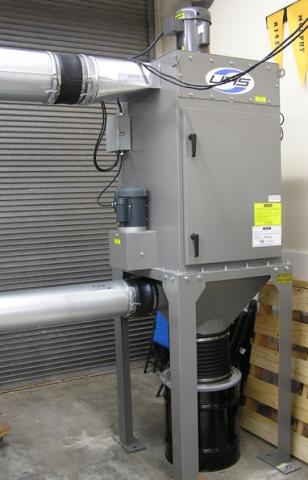Evaluation of a Shaker Dust Collector for Use in a Recirculating Ventilation System
Tom Peters, Russell Sawvel, Jae Hong Park, T. Renée Anthony
Journal of Occupational and Environmental Hygiene 12(9):D201-210
This manuscript was prepared from work performed by Russell Sawvel, a MS IH student. It describes laboratory and field performance of a filtration unit (a "Shaker Dust Collector") to be used to reduce dust concentrations inside swine production buildings. This work was supported by funding from NIOSH, as one of the research projects in the Great Plains Center for Agricultural Health (GPCAH). See Controlling Exposures in Livestock Production page to learn how this work fits into the larger project.
ABSTRACT
General ventilation with recirculated air may be cost-effective to control the concentration
of low-toxicity, contaminants in workplaces with diffuse, dusty operations,
such as in agriculture. Such systems are, however, rarely adopted with little evidence
showing improved air quality and ability to operate under harsh conditions. The goal
of this work was to examine the initial and long-term performance of a fabric-filter
shaker dust collector (SDC) in laboratory tests and as deployed within a recirculating
ventilation system in an agricultural building. In laboratory tests, collection efficiency
and pressure drop were tracked over several filter loading cycles, and the recovery of
filter capacity (pressure drop) from filter shaking was examined. Collection efficiencies
of particles larger than 5μmwas high (>95%) even when the filterwas pristine, showing
effective collection of large particles that dominate inhalable concentrations typical of
agricultural dusts. For respirable-sized particles, collection efficiencies were low when
the filter was pristine (e.g., 27% for 1 μm) but much higher when a dust cake developed
on the filter (>99% for all size particles), even after shaking (e.g., 90% for 1 μm). The
first shake of a filterwas observed to recovery a substantial fraction of filter capacity,with
subsequent shakes providing little benefit. In field tests, the SDC performed effectively
over a period of three months in winter when incorporated in a recirculating ventilation
system of a swine farrowing room. Trends in collection efficiency and pressure drop
with loading were similar to those observed in the laboratory with overall collection
efficiencies high (>80%) when pressure drop exceeded 230 Pa, or 23% of the maximum
loading recommended by the manufacturer. This work shows that the SDC can function
effectively over the harsh winter in swine rearing operations. Together with findings of
improved air quality in the farrowing room reported in a companion manuscript, this
article provides evidence that an SDC represents a cost-effective solution to improve air
quality in agricultural settings.
